Related Research Articles
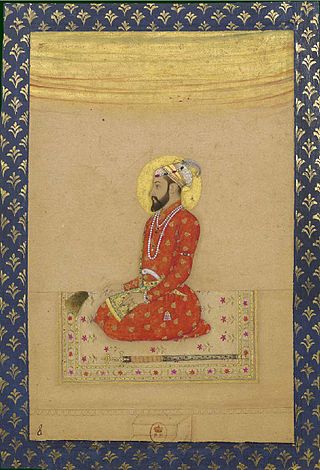
Mirza Muhammad Mu'azzam, commonly known as Bahadur Shah I and Shah Alam I, was the eighth Mughal Emperor from 1707 to 1712. He was the second son of the sixth Mughal emperor Aurangzeb, who he conspired to overthrow in his youth. He was also governor of the imperial provinces of Agra, Kabul and Lahore and had to face revolts of Rajputs and Sikhs.

Guru Gobind Singh was the tenth and last human Sikh Guru. He was a warrior, poet, and philosopher. In 1675, at the age of nine he was formally installed as the leader of the Sikhs after his father Guru Tegh Bahadur was executed by Emperor Aurangzeb. His father was the ninth Sikh Guru. His four biological sons died during his lifetime – two in battle and two executed by the Mughal governor Wazir Khan.

Guru Har Rai revered as the seventh Nanak, was the seventh of ten Gurus of the Sikh religion. He became the Sikh leader at age 14, on 3 March 1644, after the death of his grandfather and the sixth Sikh leader Guru Hargobind. He guided the Sikhs for about seventeen years, till his death at age 31.

Guru Tegh Bahadur was the ninth of ten gurus who founded the Sikh religion and was the leader of Sikhs from 1665 until his beheading in 1675. He was born in Amritsar, Punjab, India in 1621 and was the youngest son of Guru Hargobind, the sixth Sikh guru. Considered a principled and fearless warrior, he was a learned spiritual scholar and a poet whose 115 hymns are included in the Guru Granth Sahib, which is the main text of Sikhism.

Bhai Mani Singh was an 18th-century Sikh scholar and martyr. He was a childhood companion of Guru Gobind Singh and took the vows of Sikhism when the Guru inaugurated the Khalsa in March 1699. Soon after that, the Guru sent him to Amritsar to take charge of Harmandir Sahib, which had been without a custodian since 1696. He took control and steered the course of Sikh destiny at a critical stage in Sikh history. He was also a teacher of the Gianian Bunga, later becoming known as the "Amritsari Taksal", currently located in Sato Ki Gali.
Guru Nanak founded the Sikh religion in the Punjab region of the northern part of the Indian subcontinent in the 15th century and opposed many traditional practices like fasting, Upanayana, idolatry, caste system, ascetism, azan, economic materialism, and gender discrimination.

Jassa Singh Ramgarhia (1723–1803) was a prominent Sikh leader during the period of the Sikh Confederacy. He was the founder of the Ramgarhia Misl.

The Battle of Nadaun, alternatively known as the Hussaini Yudh, was fought at Nadaun, between Raja Bhim Chand of Bilaspur (Kahlur) and the Mughals under Alif Khan. Bhim Chand was supported by Guru Gobind Singh and the Mughals were supported by other hill chieftains, notably Kirpal Chand from Kangra and Dayal Chand from Bijharwal. Bhim Chand and some hill chieftains, after conclusion of Battle of Bhangani had refused to pay tribute to the Mughal emperor which led to the battle at Nadaun. The battle resulted in the victory of Bilaspur State and Sikh alliance.
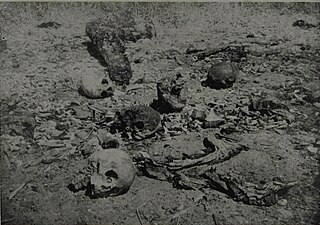
Chhota Ghallughara was a massacre of a significant proportion of the Sikh population by the Mughal Empire in 1746. The Mughal Army killed an estimated 7,000 Sikhs in these attacks while an additional 3,000 Sikhs were taken captive. Chhōtā Ghallūghārā is distinguished from the Vaddā Ghallūghārā, the greater massacre of 1762.
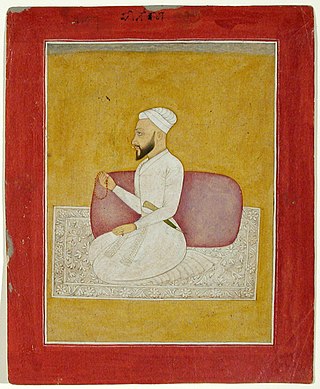
Adina Beg Khan was a general and administrator of the Mughal Empire who served as the last governor of the Punjab region, including the provinces of Lahore and Multan. He defeated the Afghans after rising to power and was recognised as the Nawab of Punjab by Mughal emperor Alamgir II, who also gave him title of Jang Bahadur.
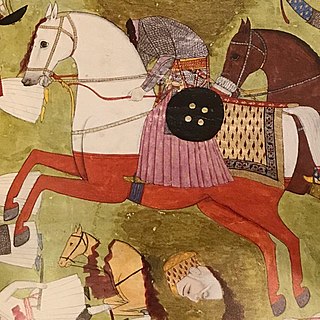
Mirza Askari, better known by his title Wazir Khan was a Mughal official notable for his conflicts with the Sikhs. He served as the Faujdar (deputy-governor) of Sirhind Sarkar of Delhi Subah in the present-day state of Punjab, and administered the territory that lay between the Sutlej and Yamuna rivers.
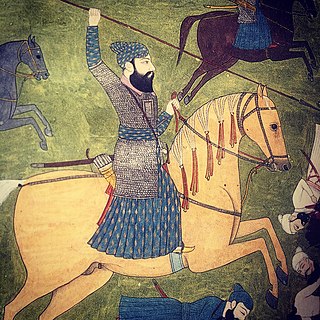
Banda Singh Bahadur; born Lachman Dev;, was a Sikh warrior and a general of the Khalsa Army. At age 15, he left home to become an ascetic, and was given the name Madho Das Bairagi. He established a monastery at Nānded, on the bank of the river Godāvarī. In 1707, Guru Gobind Singh accepted an invitation to meet Mughal Emperor Bahadur Shah I in southern India, he visited Banda Singh Bahadur in 1708. Banda became disciple of Guru Gobind Singh and was given a new name, Gurbaksh Singh(as written in Mahan Kosh), after the baptism ceremony. He is popularly known as Banda Singh Bahadur. He was given five arrows by the Guru as a blessing for the battles ahead. He came to Khanda, Sonipat and assembled a fighting force and led the struggle against the Mughal Empire.
The siege of Sirhind was fought between the Mughal Empire and Sikh forces in 1710. The Sikhs besieged, stormed, captured, plundered and razed the city of Sirhind after defeating and beheading Wazir Khan in the Battle of Chappar Chiri.
The siege of Jalalabad occurred in 1710 between the Mughal forces of Jalal Khan and the Sikh forces of Banda Singh Bahadur. Banda Singh Bahadur attacked the Mughal stronghold of Jalalabad. The army opposing Banda Singh was composed of a sizeable number of the Mughal zamindars and shurafa, including many Sadat, Banda Singh Bahadur repelled Mughal and Pathan forces after four days from the battlefield and back into the town, but failed to capture the town and withdrew.
The Jat people, also spelt Jaat and Jatt, are a traditionally agricultural community in Northern India and Pakistan. Originally pastoralists in the lower Indus river-valley of Sindh, many Jats migrated north into the Punjab region in late medieval times, and subsequently into the Delhi Territory, northeastern Rajputana, and the western Gangetic Plain in the 17th and 18th centuries. Of Hindu, Muslim and Sikh faiths, they are now found mostly in the Indian states of Punjab, Haryana, Uttar Pradesh and Rajasthan and the Pakistani regions of Sindh, Punjab and AJK.

The Battle of Rahon was fought between Sikhs and Mughal Empire on 11 October 1710.
Chung is a historical village in (Bhikhiwind), just 33 km from Tarn Taran Sahib in Patti tehsil of Tarn Taran district in the Indian state of Punjab. Before 1947, it was part of Kasur tehsil of Lahore district. Rice and wheat are the most cultivated crops.
Isa Khan Manj, was a Punjabi Muslim warlord from the Manj tribe of the cis-Sutlej territory in the Mughal Empire. He is credited with the killing of the Mughal prince Azam Shah during the Battle of Jajau, and for establishing an independent territory that defied Mughal authority.

The Akal Sena was the Sikh military force established by the sixth Sikh Guru, Guru Hargobind. It was the first standing Sikh army. It was also known as the Akali Dal.
Lakhpat Rai was the brother of Jaspat Rai and an enemy of the Sikhs. Lakhpat was the revenue minister of Lahore and wanted to take revenge on the Sikhs. He convinced the Mughal governor to take action against the Sikhs. Yahya Khan helped him in a large scale massacre of Sikhs called the Chhota Ghallughara, in which an estimated 7,000 Sikhs were killed. However, Purnima Dhavan gives a smaller figure of 400 Sikhs being killed in the massacre. He was later killed by the Sikhs. His son, Dalpat Rai, sought asylum in Jammu State and settled there.
References
- ↑ Grewal, J. S. (1998). The Sikhs of the Punjab, Volumes 2-3. Cambridge University Press. p. 90. ISBN 9780521637640.
- ↑ Singha, H. S (2000). The encyclopedia of Sikhism (over 1000 entries). Hemkunt Press. p. 110. ISBN 978-81-7010-301-1 . Retrieved 22 December 2011.
- ↑ Dhavan, Purnima (2 November 2011). When Sparrows Became Hawks: The Making of the Sikh Warrior Tradition, 1699-1799. Oxford University Press. pp. 90–91. ISBN 9780199877171.